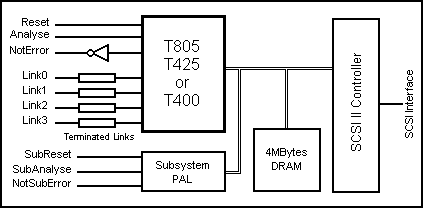"…sequential computers are approaching a fundamental physical
limit on their potential power. Such a limit is the speed of light…"
![]()

|
The HPT04 SCSI TRAM from C.O.R.A.L. is quite simply the smallest, highest performance SCSI controller available. Implemented as a size-2 TRAM module, the HPT04 can achieve bus transfer rates up to 10Mbytes/sec and with the provision of a local 32 bit transputer and 4Mbytes of RAM, it can provide uncompromising performance in any mix of high I/O rate and high data rate environments.
Extensive software support is provided, allowing the HPT04 to interface at the SCSI command level in a standalone environment with a wide range of SCSI and SCSI-2 peripherals. The HPT04 is also upwards compatible with the I0.5Mbyte HPT01 it replaces. A fast standalone file system, HDFS, is also available. Under the Helios operating system, the HPT04 can be accessed at the SCSI command level or via the Helios File System.
|
The ultimate in SCSI performance. The HPT04 can support synchronous transfer rates up to 10Mbytes/sec, implementing many of the performance enhancement features of SCSI-2. With this provision of a local T4/T8 32 bit processor and 4Mbytes RAM, genuine transfer rates close to this figure can be sustained – if you can find targets fast enough!
Small size, full featured. For all its capabilities, the HPT04 is one of the smallest SCSI TRAMs available, occupying only two standard TRAM slots and connecting upwards directly onto the SCSI bus. Active bus termination is implemented for optimum bus performance. Removable bus termination, optional terminator power and SCSI address jumpers are all provided. With TRAM expansion space always at a premium, the HPT04 provides a neat, no compromise solution to high performance SCSI.
Full boot capability. The HPT04 has full Subsystem Reset/Error/Analyse control, and can be ‘piggybacked’ with a size-1 ROM boot TRAM to provide a fully bootable node under Helios, for example.
Local application support. The HPT04 has considerable dedicated RAM and processor capacity so significant application code can actually reside on the HPT04 TRAM, even after the driver code and buffering is loaded. Compared with a T2-based SCSI TRAM where an external compute TRAM is usually needed just to host the buffering and file support for the application itself, the HPT04 can achieve major size and cost benefits.
|
HPT04 common firmware. The performance of a fast SCSI implementation is crucially dependent on the design of the low-level software. C.O.R.A.L.’s primary design goal for this software was to achieve close to the theoretical performance of the hardware without compromising ease of use or reliability.
The HPT04 software negotiates SCSI bus options between initiator and target, and handles these transactions transparently. The software also intelligently monitors command traffic and SCSI bus events to track the state of each target in the system, dealing with the consequences of events such as a device and bus reset, MODE SELECT commands and CHECK CONDITION/REQUEST SENSE status. Intelligent recovery algorithms will perform transparent retries where possible.
The HTP04 software can use the C.O.R.A.L TDP to communicate across links and/or channels with the applications making the SCSI device-level interface calls. TDP provides aggregation of two or more links into a single width logical path, multiplying the single link bandwidth by two or more accordingly. Also, should two (or more) application tasks wish to use a single peripheral, TDP will share a single link path transparently amongst competing callers. The HPT04 software can be configured to converse over all four links, and any link using the TDP protocol can also provide a through-routing path for other TDP-based TRAMS.
SCSI device-level interface. Inmos ANSI C, 3L C and Helios C library support allows a simple, procedural interface to send SCSI commands and receive replies. Most common ANSI X3.131, CCS and SCSI-2 features and options are supported, and the software is efficient and robust by design, yet tolerant of user programming errors and device failures.
Device checkout utility. Available in Inmos/iserver, 3L/afserver, and Helios task image formats, this menu driven utility provides a confidence test of the HPT04, SCSI bus and connected devices, a performance test of any HPT04/target combination, and a way of performing management and housekeeping functions such as disk format, tape erase etc.
Helios file system. A Helios device driver is available to implement the Helios File System with SCSI disk devices via an HPT04, and to provide SCSI command level access to SCSI devices directly. The device checkout utility uses this device driver under Helios. Bootable disk support will also be available.
High Data-rate File System. In applications where a full file systems is unnecessary but guaranteed data rates are required for data logging and similar applications, the High Data-rate File System (HDFS) will be available as an option on the HPT04. HDFS combines simple named-file ease of use with continuous transfer rates close to the device maximum.
|
This page is copyright ©1995, Sundance Multiprocessor Technology Ltd.